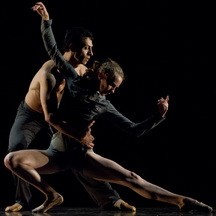
Amy Seiwert’s ‘Soon These Two Worlds’
The Smuin Ballet opened its winter concert at the Dean Lesher Center for the Arts this past weekend with Choreographer-in-Residence Amy Seiwert’s Soon These Two Worlds and two Michael Smuin repertory ballets, Medea (premiered by San Francisco Ballet in 1977 during Smuin’s tenure as the company’s co-artistic director), and Fly Me to the Moon (2004), one of Smuin’s last ballets before his unexpected death in 2007.
Set to excerpts from the Kronos Quartet’s Pieces of Africa, which is a series of compositions by African composers, Seiwert’s Soon These Two Worlds uses ballet movements as its foundational dance vocabulary. The bodies are upright with ballet’s distinctive carriage, but circular movements are emphasized: arms round and open as if holding baskets, hips tracing circles, and bodies flung into double tours en l’air.
Along with these circular gestures are several movements that break traditional ballet lines. Although the dancer’s feet are never flexed, their knees are, and a wide plié in second position is an often-repeated movement. The choreography places the line against the curve throughout.
Although the ballet is set to African music, it overlaps with African dance in its use of rhythm as the dance’s primary driving force rather than its gesticulations.
The ballet’s title comes from a poem, “Sunset,” by Rainer Maria Rilke: “Slowly the west reaches for clothes of new colors/ which it passes to a row of ancient trees./ You look, and soon these two worlds both leave you/ one part climbs toward heaven, one sinks to earth.” This idea of two elements—represented by the male and female dancers—runs through the entire ballet.
Each section of the dance is led by a couple, and in this way Seiwart’s choreography merges with Smuin’s, which was most often based on the Romantic ballet tradition of the loving couple exalted. The third movement, “Tilliboyo,” features an especially fetching pas de deux, danced by Erin Yarbrough-Stewart and Aaron Thayer, with some exacting lifts that seemed all curvaceous limbs rolled over against the body of the male partner. The entire ballet ended with the female dancer throwing herself into the arms of her partner in a tight embrace, face pressed tight against face, punctuating their union like an exclamation mark at the end of a sentence.
Smuin repertory
The second ballet on the program, Medea, tells the ancient Greek story with a slightly different emphasis than Euripides’ play. Medea and Jason’s sons are barely present in the drama, but they appear in the ballet as a pair of tumbling twins, powerfully athletic, turning cartwheels across the stage and acting as demonic accomplices in Medea’s murder of her rival, the Corinthian princess, Creusa. Ryan Camou and John Speed Orr danced the imposing and very active sons, who are born out of the smoky interior of the jealous Medea’s night-gathering cloak. The tallest member of the company, Matthew Linzer, powerfully long limbed, danced Jason, and Robin Cornwell danced an elegantly heartless Medea. The exquisitely boned Terez Dean danced Creusa, adding a childlike innocent blended with willfulness to her delicately poised solo.
Smuin’s light-hearted Fly Me to the Moon is set to a series of Frank Sinatra songs. The male dancers dressed in suits, vests and hats; the women in short, pastel cocktail dresses. Of the eight dances that comprise the piece, “That’s Life” stood out for its imaginative choreography and some truly dazzling dancing by Ryan Camou.
—Jaime Robles
The Smuin Ballet’s winter concert continues at the following dates and venues: Wednesday–Friday, February 24–26, 8 p.m.; Saturday, February 27, 2 p.m. and 8 p.m.; Sunday, February 28, 2 p.m. Mountain View Center for the Performing Arts, 500 Castro St., Mountain View. 650-903-6000 or visit www.smuinballet.org. Friday, March 5, 8 p.m.; Saturday, March 6, 2 p.m. and 8 p.m. Sunset Center, San Carlos Street, Carmel. 831-620-2048 or www.smuinballet.org.
Originally published in the Piedmont Post
